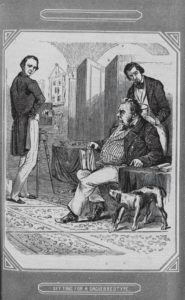By Sarah Gillespie (Guest Contributor)
Mid-nineteenth-century American society liked to tout its eagerness to embrace the new. The term “go-ahead” was often shorthand to indicate the nation’s forward-looking character, as when Samuel F. B. Morse remarked upon his telegraph: “There is more of the ‘Go-ahead’ character with [Americans], suited to the character of the electro-magnetic telegraph.” Despite Americans’ belief in their own progressiveness with regard to new technologies, the French invention of the daguerreotype (one of the first photographic processes) was initially met with uncertainty, skepticism, and wariness on the part of Americans.

Timothy Shay Arthur’s “Sitting for a Daguerreotype,” in Sketches of Life and Character. Philadelphia: J. W. Bradley, 1850.
Perhaps it was due to the aura of the supernatural around the radical idea of a reflection being captured and held. The operator had the slight aura of a conjurer, disappearing behind a curtain before emerging to reveal, as if by magic, the image floating upon the silvered, finished plate. A magazine called The Pathfinder exclaimed: “When [the daguerreotype was] first announced, most persons imagined it to be a delusion. It seemed at the time utterly incredible.” A group of artists in Philadelphia, upon reading an early letter describing the new process, mocked the idea: “[The letter] was received with considerable ridicule by most present. After the discussion the consensus of the meeting was that they could believe Herschel’s moon story, but this one—never.” “Herschel’s moon story” was a famous hoax in which a series of newspaper articles falsely attributed to British scientist Sir John Herschel fooled New Yorkers into believing all kinds of fantastic creatures lived on the moon, such as men with bat wings. The New York Morning Herald admitted, about the daguerreotype, “I am aware that you will think that this is a second moon hoax, and so I thought till sufficient reasons were adduced, when I was forced to the belief.” Humor was often used to mask this uncertainty about the technology: “Every thing and every body may have to encounter his double every where, most inconveniently.”
Language of the otherworldly is often apparent in early commentaries about the daguerreotype; it was characterized as having “magic power,” and the camera itself was referred to as the “magic box.” In addition, the final image was thought to rarely resemble the subject.
Perhaps, despite their optimism, mid-nineteenth-century Americans were simply overwhelmed with the ever-widening array of rapidly evolving technologies. One of the earliest written descriptions of the daguerreotype, published in the U.S. in April 1839, described a sort of bewilderment around the new medium: “Invention . . . has found out the one new thing under the sun. . . . There is no breathing space—all is one great movement. Where are we going? Who can tell? The phantasmagoria of inventions passes rapidly before us—are we to see them no more?”
Americans eventually overcame their uncertainties regarding the daguerreotype. Indeed, they took ownership of it to the point that by the 1850s they had two journals devoted to the form and bragged that American improvements had earned the daguerreotype the nickname “the American process.”

 Sarah Kate Gillespie is curator of American art at the Georgia Museum of Art, University of Georgia. Her book The Early American Daguerreotype: Cross-Currents in Art and Technology was published by MIT Press in 2016. Her next book, Vernacular Modernism: The Photography of Doris Ulmann, will accompany a 2018 exhibition on the photographer.
Sarah Kate Gillespie is curator of American art at the Georgia Museum of Art, University of Georgia. Her book The Early American Daguerreotype: Cross-Currents in Art and Technology was published by MIT Press in 2016. Her next book, Vernacular Modernism: The Photography of Doris Ulmann, will accompany a 2018 exhibition on the photographer.
